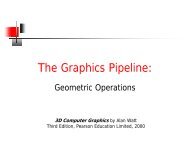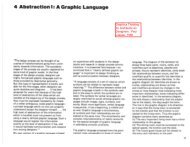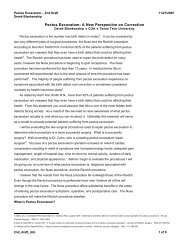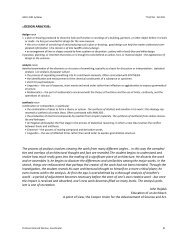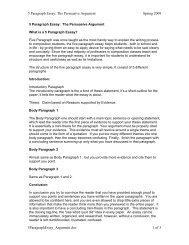The Eyes of the Skin
The Eyes of the Skin
The Eyes of the Skin
You also want an ePaper? Increase the reach of your titles
YUMPU automatically turns print PDFs into web optimized ePapers that Google loves.
vision down to touch. <strong>The</strong> Renaissancesystem <strong>of</strong> <strong>the</strong> senses was relatedwith <strong>the</strong> image <strong>of</strong> <strong>the</strong> cosmic body; vision was correlated to fire and light,hearing to air, smell to vapour, taste to water, and touch to earth. 11<strong>The</strong> invention <strong>of</strong> perspectival representation made <strong>the</strong> eye <strong>the</strong> centrepoint <strong>of</strong> <strong>the</strong> perceptual world as well as <strong>of</strong> <strong>the</strong> concept <strong>of</strong> <strong>the</strong> self.Perspectival representationnot only describes but also conditions perception.itself turned into a symbolic form, one which<strong>The</strong>re is no doubt that our technological culture has ordered and separated<strong>the</strong> senses even more distinctly. Vision and hearing are now <strong>the</strong>privileged sociable senses, whereas <strong>the</strong> o<strong>the</strong>r three are considered asarchaic sensory remnants with a merely private function, and <strong>the</strong>y areusually suppressed by <strong>the</strong> code <strong>of</strong> culture. Only sensations such as <strong>the</strong>olfactory enjoyment <strong>of</strong> a meal, fragrance <strong>of</strong> flowers and responses to temperatureare allowed to draw collective awareness in our ocularcentric andobsessively hygienic code <strong>of</strong> culture.<strong>The</strong> dominance <strong>of</strong> vision over <strong>the</strong> o<strong>the</strong>r senses - and <strong>the</strong> consequent biasin cognition - has been observed by many philosophers. A collection <strong>of</strong>philosophical essays entitled Modernityand <strong>the</strong> Hegemony if Vision 1 2 argues that'beginning with <strong>the</strong> ancient Greeks, Western culture has been dominated byan ocularcentric paradigm, a vision-generated, vision-centred interpretation<strong>of</strong> knowledge, truth, and reality'.13 This thought-provoking book analyses'historical connections between vision and knowledge, vision and ontology,vision and power, vision and ethics'. 14As <strong>the</strong> ocularcentric paradigm <strong>of</strong> our relation to <strong>the</strong> world and <strong>of</strong> ourconcept <strong>of</strong> knowledge - <strong>the</strong> epistemologicalprivileging <strong>of</strong> vision ~ hasbeen revealed by philosophers, it is also important to survey critically <strong>the</strong>role <strong>of</strong> vision in relation to <strong>the</strong> o<strong>the</strong>r senses in our understanding andpractice <strong>of</strong> <strong>the</strong> art <strong>of</strong> architecture. Architecture, as with all art, is fundamentallyconfronted with questions <strong>of</strong> human existence in space andtime, it expresses and relates man's being in <strong>the</strong> world. Architecturedeeply engaged in <strong>the</strong> metaphysicalquestions <strong>of</strong> <strong>the</strong> self and <strong>the</strong> world,interiority and exteriority, time and duration, life and death. 'Aes<strong>the</strong>ticisand cultural practices are peculiarly susceptible to <strong>the</strong> changing experience<strong>of</strong> space and time precisely because <strong>the</strong>y entail <strong>the</strong> construction <strong>of</strong> spatialrepresentations and artefacts out <strong>of</strong> <strong>the</strong> flow <strong>of</strong> human experience,' writesDavid Harvey. 15 Architecture is our primary instrument in relating us withspace and time, and giving <strong>the</strong>se dimensions a human measure. It domesticateslimitless space and endless time to be tolerated, inhabited andunderstood by humankind. As a consequence <strong>of</strong> this interdependence <strong>of</strong>space and time, <strong>the</strong> dialectics <strong>of</strong> external and internal space, physical andspiritual, material and mental, unconscious and conscious priorities concerning<strong>the</strong> senses as well as <strong>the</strong>ir relative roles and interactions, have anessential impact on <strong>the</strong> nature <strong>of</strong> <strong>the</strong> arts and architecture.David Michael Levin motivates <strong>the</strong> philosophical critique <strong>of</strong> <strong>the</strong> dominance<strong>of</strong> <strong>the</strong> eye with <strong>the</strong> following words: 'I think it is appropriatechallenge <strong>the</strong> hegemony <strong>of</strong> vision - <strong>the</strong> ocularcentrism <strong>of</strong> our culture.And I think we need to examine very critically <strong>the</strong> character <strong>of</strong> visionthat predominates<strong>the</strong> psychosocial pathologytoday in our world. We urgently need a diagnosis <strong>of</strong><strong>of</strong> everyday seeing - and a critical understanding<strong>of</strong> ourselves, as visionary beings.' 16Levin points out <strong>the</strong> autonomy-driveand aggressiveness <strong>of</strong> vision, and'<strong>the</strong> specters <strong>of</strong> patriarchal rule' that haunt our ocularcentric culture:<strong>The</strong> will to power is very strong in vision. <strong>The</strong>re is a very strong tendencyin vision to grasp and fixate, to reify and totalise: a tendency to dominate,secure, and control, which eventually, because it was so extensively promoted,assumed a certain uncontestedhegemony over our culture and itsphilosophical discourse, establishing, in keeping with <strong>the</strong> instrumentalrationality <strong>of</strong> our culture and <strong>the</strong> technological character <strong>of</strong> our society,an ocularcentric metaphysics <strong>of</strong> presence. 17I believe that many aspects <strong>of</strong> <strong>the</strong> pathology <strong>of</strong> everyday architecture todaycan likewise be understood through an analysis <strong>of</strong> <strong>the</strong> epistemology <strong>of</strong> <strong>the</strong>senses, and a critique <strong>of</strong> <strong>the</strong> ocular bias <strong>of</strong> our culture at large, and <strong>of</strong>architecture in particular. <strong>The</strong> inhumanity <strong>of</strong> contemporary architectureand cities can be understood as <strong>the</strong> consequence <strong>of</strong> <strong>the</strong> negligence <strong>of</strong> <strong>the</strong>to16THE EYES OFTHE SKINPART I 17






